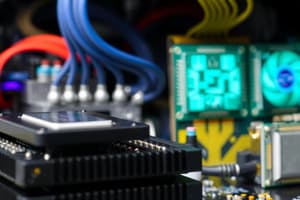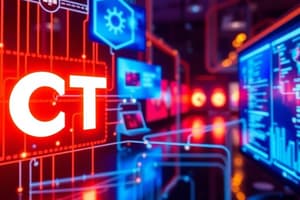Podcast
Questions and Answers
Which machine is primarily used for creating 3D digital images of body parts?
Which machine is primarily used for creating 3D digital images of body parts?
- MRI Machine
- Cardiac Screening Machine
- ECG Machine
- CAT Machine (correct)
What is the main use of telemedicine in healthcare?
What is the main use of telemedicine in healthcare?
- To record electrical impulses of the heart
- To create digital images of internal organs
- To monitor blood pressure
- To facilitate remote surgeries (correct)
Which technology is NOT typically used for automated agricultural practices?
Which technology is NOT typically used for automated agricultural practices?
- Telemedicine (correct)
- Seedlings plant robots
- CCTV farm monitoring
- Drip irrigation
Which of the following machines is responsible for monitoring heart activity?
Which of the following machines is responsible for monitoring heart activity?
What is one application of ICT in transport?
What is one application of ICT in transport?
Which device is used to assess weather conditions in agriculture?
Which device is used to assess weather conditions in agriculture?
What function does RFID tagging serve in agriculture?
What function does RFID tagging serve in agriculture?
Which technology is utilized for general production in industries?
Which technology is utilized for general production in industries?
What are some common side effects of computer game addiction?
What are some common side effects of computer game addiction?
Which category of computer hardware does NOT include input devices?
Which category of computer hardware does NOT include input devices?
What is a distinguishing feature of microcomputers?
What is a distinguishing feature of microcomputers?
What limitation is inherent to computers?
What limitation is inherent to computers?
Which of the following was a characteristic of first-generation computers?
Which of the following was a characteristic of first-generation computers?
Which generation of computers is known for using transistors?
Which generation of computers is known for using transistors?
What is NOT a characteristic of computers?
What is NOT a characteristic of computers?
Which of the following is a characteristic of mainframe computers?
Which of the following is a characteristic of mainframe computers?
What does ICT primarily stand for?
What does ICT primarily stand for?
Which process involves converting text, pictures, or sound into a digital form?
Which process involves converting text, pictures, or sound into a digital form?
What is a Learning Management System used for?
What is a Learning Management System used for?
Which of the following is NOT a function of ICT?
Which of the following is NOT a function of ICT?
Which of the following technologies is used for communication within ICT?
Which of the following technologies is used for communication within ICT?
What is the purpose of E-government services?
What is the purpose of E-government services?
Which step involves applying algorithms to obtain new information from data?
Which step involves applying algorithms to obtain new information from data?
What does digital storage allow in ICT?
What does digital storage allow in ICT?
Which technology was introduced during the Third Generation of computers?
Which technology was introduced during the Third Generation of computers?
What significant feature was developed in Fourth Generation computers?
What significant feature was developed in Fourth Generation computers?
Which of the following represents a characteristic of Fifth Generation computers?
Which of the following represents a characteristic of Fifth Generation computers?
What is a prominent feature of microprocessors found in Fourth Generation computers?
What is a prominent feature of microprocessors found in Fourth Generation computers?
What is an example of high-level programming languages introduced during the Third Generation?
What is an example of high-level programming languages introduced during the Third Generation?
In what way did Third Generation computers differ from their predecessors?
In what way did Third Generation computers differ from their predecessors?
Which of the following was NOT a characteristic of Fourth Generation computers?
Which of the following was NOT a characteristic of Fourth Generation computers?
Which component is responsible for executing the set of instructions in a computer?
Which component is responsible for executing the set of instructions in a computer?
Which output device is classified as an impact printer?
Which output device is classified as an impact printer?
Which type of port transmits data one bit at a time?
Which type of port transmits data one bit at a time?
What device is used to connect up to 127 peripheral devices?
What device is used to connect up to 127 peripheral devices?
What type of printer is known for producing less noise but better quality?
What type of printer is known for producing less noise but better quality?
Which of the following is NOT considered an output device?
Which of the following is NOT considered an output device?
Which processor manufacturer is associated with dual-core technology?
Which processor manufacturer is associated with dual-core technology?
Which device uses Optical Character Recognition technology?
Which device uses Optical Character Recognition technology?
What type of display device utilizes Light Emitting Diode technology?
What type of display device utilizes Light Emitting Diode technology?
Study Notes
Chapter 1: Introduction to ICT
- ICT stands for Information Communication and Technology; it encompasses methods, systems, and devices enabled by scientific knowledge for practical use.
- Information represents meaningful data, processed by various technologies for communication such as radio, TV, and newspapers.
- ICT allows for global communication at any time by anyone, enabling digitization, storage, processing, transmission, and retrieval of digital data.
- Digitization involves converting text, images, or audio into a format manageable by computers.
- Key components of ICT include information systems for various sectors:
- E-government services facilitate citizens' access to government information.
- Education services utilize web-based platforms for learning materials and online courses, supported by Learning Management Systems.
- The health sector employs advanced machinery like CAT and MRI machines for diagnostics, and telemedicine for remote healthcare.
- Agriculture benefits from ICT devices like automated insect control and weather monitoring systems.
- Industries leverage automation, e-banking, and online shopping platforms.
- Transport utilizes ICT for traffic monitoring and intelligent systems.
- Drawbacks of ICT include addiction to gaming, physical ailments, negative social interactions, and mental health issues.
Chapter 2: Introduction to Computer
- A computer is an electronic device that processes data, stores it, and generates user-output; it consists of hardware and software.
- Hardware refers to the physical components, while software consists of instructions that direct the hardware.
- Characteristics of computers include speed, reliability, accuracy, and storage capacity, but they lack intelligence and emotions.
- Computer classifications include:
- Supercomputers for intensive computations.
- Mainframe computers for large data processing.
- Minicomputers for laboratory uses.
- Microcomputers for everyday tasks.
- Historic generations of computers:
- First Generation (1940-1956): Utilized vacuum tubes, large size, and high power consumption.
- Second Generation (1956-1963): Used transistors, smaller size, and more efficient power usage.
- Third Generation (1964-1975): Features integrated circuits and the birth of operating systems.
- Fourth Generation (1975-1989): Introduced microprocessors and personal computers with graphics user interfaces.
- Fifth Generation (1989-present): Focus on artificial intelligence and advanced processing capabilities.
Parts of Computers
- Hardware components include:
- CPU (Central Processing Unit): Executes programs, measured in MHz.
- ALU (Arithmetic Logic Unit): Performs arithmetic and logical operations.
- Memory: Divided into volatile (temporary) and non-volatile (permanent).
- Input devices enable instructions and data entry, including keyboards, mice, scanners, and microphones.
- Output devices produce data output in various forms:
- Display devices (CRT, LCD, LED), printers (impact and non-impact), and speakers.
- The motherboard and computer ports define connectivity and communication:
- Types of ports include Parallel, Serial, PS/2, USB, and SCSI, each serving different peripheral connections and data transmission speeds.
- Processor manufacturers include Apple, Intel, and AMD; processor types range from single-core to multi-core architectures.
Studying That Suits You
Use AI to generate personalized quizzes and flashcards to suit your learning preferences.
Related Documents
Description
Explore the fundamentals of Information Communication and Technology in this introductory quiz. Discover what ICT entails, the role of technology, and the significance of information in communication. This quiz offers a foundational understanding essential for your studies in ICT.




